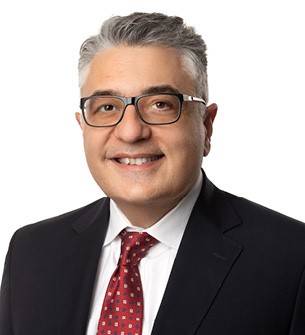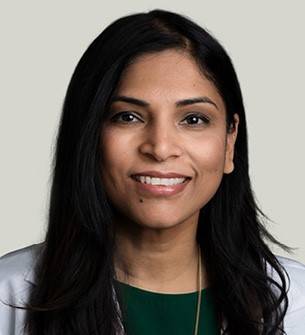Communication is essential to most every profession. In radiology, effective communication has become increasingly important as the specialty shifts from prioritizing the volume of scans read to the value of care provided. Now more than ever, radiologists must make conscious efforts beyond image interpretation to interact with technologists, business staff, and other radiology colleagues, as well as referring providers, healthcare administrators, and even patients to demonstrate the value they bring to the care team.
To encourage radiologists at the University of Chicago Medicine to be effective in internal and external communications, Aytekin Oto, MD, MBA, professor of radiology and surgery and chair of radiology, is launching a formal communication effort within radiology. He has started with the innovative approach of creating a new role within the department — vice chair of communications — and has selected Kirti M. Kulkarni, MD, associate professor of radiology and director of the breast imaging fellowship program, for the position.
Oto and Kulkarni recently spoke with Imaging 3.0TM staff to discuss the value of communication in radiology and how they plan to leverage this “soft skill” to help the department move toward greater value-based care.

Aytekin Oto, MD, MBA, professor of radiology and surgery and chair of radiology, is launching a formal communication effort within radiology. |

Kirti M. Kulkarni, MD, associate professor of radiology and director of the breast imaging fellowship program, is leading communication efforts as the vice chair of communications in the radiology department at the University of Chicago. |
Q. How did you come up with this idea to focus on communication? What problem were you trying to solve?
Oto: As section chief and then when I became interim chair in 2019 and then permanent chair in 2020, one of the things that struck me was difficulty of communication. We are bombarded with a number of different tools to communicate, but actually communicating effectively can be really tricky. As I thought about it, I identified three core areas of communication that we needed to address: 1) within the department, both between the administration and faculty and between faculty and residents; 2) within the hospital, the biological sciences division, and the university at large; and 3) outside of our institution with patients, potential recruits, alumni, community, and potential donors. When I started thinking about this in more detail, I knew we needed to develop a structure if we wanted to improve our communication at each of these levels.
Kulkarni: Communication became even more strained with the pandemic and the remote working environment. Day-to-day communication, which previously used to happen, say, in the conference room or if you bumped into someone in the hallway, all gradually disappeared. We started relying heavily on digital means of communication, mainly Zoom calls and emails. While there are some advantages to the remote setup, such as the opportunity to collaborate regardless of your location and better work-life integration, there has to be a right balance between the face-to-face and digital communication.
Q. Why did you appoint someone to the vice chair of communications role? Why did you need someone in that position?
Oto: In recognizing how complicated communication can be, I knew we needed a champion to organize and lead this effort, and to engage with people and get it off the ground. I envisioned this person to be the champion of communication and constantly look for opportunities for us to improve communication. With Dr. Kulkarni in this role, we are developing a robust communication strategy that addresses those three specific communication avenues that I mentioned.
Q. Why did you select Dr. Kulkarni for this position?
Oto: I’ve known Dr. Kulkarni for a very long time. I know her ambitions and skills, and how much she values communication. We had a number of conversations about our communication needs, and she even created and shared a slide deck summarizing her ideas. She already had a couple of successful YouTube videos, and she mentioned all these non-conventional communication methods, including videos, audio, and images, that can bring the department together. It was very clear from our conversations that we shared the same vision, and we understand that communication is a multidimensional goal, which includes not only our own faculty, but also beyond that, other members of the institution, prospective recruits, and patients.
Q. What made you want to take on this role, Dr. Kulkarni?
Kulkarni: I am passionate about the art of communication, and I am very transparent. I like to build camaraderie with the people that I work with. People sometimes carry emotional baggage at the workplace, which sometimes inhibits them from expressing themselves and collaborating with other people. If we focus on improving everyone’s emotional intelligence, which is being self-aware and being able to self-regulate and handle interpersonal relationships a little more empathetically, we might be able to do better as an organization. Positive interactions create better communications, better connections, and better outcomes.
Q. What are some initial steps you are taking to make communication a central part of your department?
Kulkarni: To start, we are building a team of people with different strengths. We’ll have an individual with a marketing background who can share ideas about branding and other strategies that will help us communicate our dedication to placing patients at the center of all we do. We’ll have an individual with creative art and writing skills who can guide our content management and design work for a more robust website with updates that will increase our visibility to the external audience, including patients, alumni, potential residents and fellows, and potential new faculty members. We’re also thinking about creating videos with our faculty to educate referring physicians about appropriate imaging and also educating our patients about how to prepare for and what to expect from different imaging exams.
We’ll emphasize communication in the department through our daily teachings with the residents and our interactions with other departments and patients. We want to focus on creating an environment in which people are emotionally invested in their jobs, where they feel that they are making progress and that their goals matter to the leadership. This is critical to creating a workplace where people don’t just come for paychecks, but come for growth and for a sense of fulfillment, which in turn leads to better patient care.
Q. Why is patient communication important for the radiology team?
Oto: Communication with patients is especially important for radiology because as we know, radiologists have historically been behind the scenes, and unfortunately, despite all of the efforts, the radiology profession is still not well known to patients. Some patients even question whether radiologists are physicians or not. We want to improve our communication with the patients so that they actually know who we are. That’s number one. The other point is that improving communication with the patient is also very much in line with ACR’s Imaging 3.0 concept. With this concept, we are revisiting the importance of the value that we provide as radiologists. Part of that value lies in effectively engaging with patients. By improving communication with patients, we can better understand their needs, and we can modify our service to best meet those needs.
Kulkarni: Along those lines, one of the suggestions that I had was that at the end of our reports, we could have a picture and web link for the attending radiologist who read the imaging exam. In the patient portal, the picture could be paired with a URL that links to the website, where they can get to know the accomplishments of the attending. Like Dr. Oto mentioned, few patients know that we have taken care of them. We want to take ownership of patients, and we want them to know that we are their physicians and an integral part of the interdisciplinary team.
Q. How can communication efforts like this help the profession at large?
Oto: Radiology is commonly seen as a commodity. But as radiologists, we know that imaging is not a commodity. It actually matters how your images are acquired. It matters how your images are interpreted and who interprets them. So, I think the only way to make sure that the community at large understands radiology better will be with us better communicating about our role and the added value that we provide to our patients. When I go for imaging, I always make sure that the image quality is good and the people who interpret it are the right people who know what they are doing. But patients don’t have that mindset yet. And the only people who could advocate for that are radiologists.
Q. What advice would you give to other radiology groups that might want to follow your lead and improve their communication efforts?
Kulkarni: If a department’s leadership is not ready to look into this, I encourage the faculty members to take the lead and invest time in promoting clarity of communications for stronger working relationships, for a cohesive culture, for a better patient-employee experience, and for more visibility. Take an iterative approach, starting at an individual level, then working as a small team, then eventually as a department, and then as an organization as a whole. Some people just don’t want to interact or be part of a group. And I think that needs to change.
In the past, radiologists could be in the dark room or be remote and reading scans, but not anymore. They need to be visible through their reports, their patient management processes, and their interdisciplinary approach. There are so many examples in which our impact on patient care has been much better and more effective because of our team-work with the interdisciplinary team, and within the department. For example, when focusing on quality of images, having clarity in communication with the technologists is important and it will reap high returns. And if you’re in a teaching institution, all the more, I think the onus is on you, how you teach or talk to the residents and focus on these soft skills. It will really make or break their career in the future because the ability to effectively communicate is the future of radiology.



